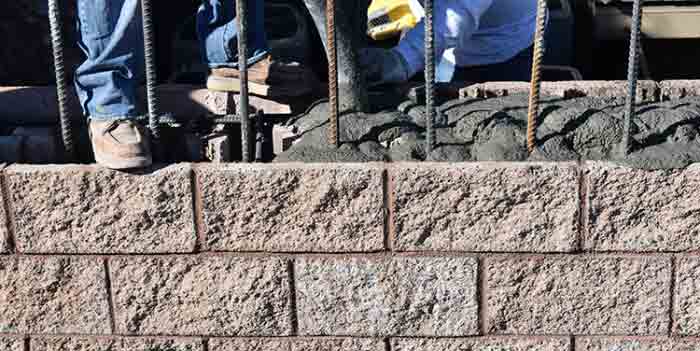As you learned in our article, Mortar vs. Grout, grout is a product that fills voids so it must flow. Masonry grout is made from cement, fine aggregates, and enough water to be fluid.
Grout is used for a number of purposes. Most often, it is used to tie vertical steel reinforcement to the masonry units in a block wall. Therefore, it must be fluid enough to fill all voids, but eventually strong enough to bond the steel and masonry together. Another use for grout is to add mass to a block wall to reduce sound transmission or improve the thermal mass of the wall.

Grout specifications are governed by ASTM C476 Standard Specification for Grout for Masonry, which provides the proportions of materials to be used. There are two main types of grout:
Fine Grout
Fine grout uses aggregates that are smaller than 3/8". It will have the same compressive strength as coarse grout. However, the benefit is that fine grout will flow better between tight spaces so it should be used when reinforcing bars are close to each other. In addition, fine aggregates do not separate as easily so fine grout can be poured from a higher distance.
Coarse Grout
Coarse grout uses fine aggregates, but it will also include aggregates that are as large as 1/2" in diameter. Coarse grout is used when reinforcing bars are spaced further apart and when there are larger spaces between the bars and the masonry. Coarse grout is used whenever possible since it is a more economical mix due to the fact that coarse aggregates are cheaper and take up more space.
Water Content in Masonry Grout
The amount of water in a grout mixture is very important because the grout needs to flow easily, but it also needs to achieve a proper compressive strength. In addition, the masonry units will immediately absorb some of the water in the mix so that needs to be taken into account for the grout mix to remain fluid. When placing grout in a hot and dry climate, it is very important to take the water content into account.
Grout Admixtures
Additives can be included in the mix to help achieve certain properties that may not be possible with traditional mixes. It is important that admixtures be included only when specified because they can affect the compressive strength of the grout. Specifiers should consult a structural engineer prior to using admixtures.
Non-Shrink additives will prevent the shrinkage that occurs as water is absorbed from a mix. The admixture will expand as water evaporates or is absorbed by adjacent materials. Non-shrink grout is most often used to transfer compressive force across a void between two structural members.
Plasticizers replace water in a grout mix in an effort to keep a fluid mix with a limited amount of water. The reduction in water will allow the grout to develop a higher compressive strength.
A retarder will slow the set time of the grout. This will allow the grout to remain fluid and workable in extremely hot or dry weather conditions.
An accelerator will make the grout set faster than normal. This is typically used in very cold conditions to prevent ice crystals from forming in the grout and to reduce the amount of time that the construction needs to be protected from the cold.
Specifying Grout
As with mortar, masonry grout is specified by using either the performance method or the proportion method. It is important that the specifier understand the structural requirements that the project must adhere to so that the grout can be specified correctly - when in doubt, be sure to consult a structural engineer.
A Performance Specification will dictate a compressive strength that the grout must achieve after having set for 7 days and also the final compressive strength after 28 days. The performance specification requires laboratory tests to confirm the mix will perform as needed, so it is used only in the most critical situations.
Most often, a Proportion Specification is used. In this case, the specifier will identify the amount of cement, aggregates (fine and coarse), water, and any additives required. The quantities are specified by either weight or volume. Since this allows the mix to be created in the field without further testing, it is the most common specification method.


